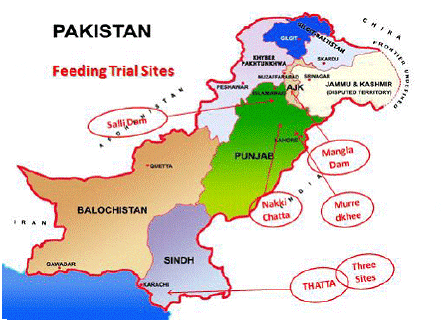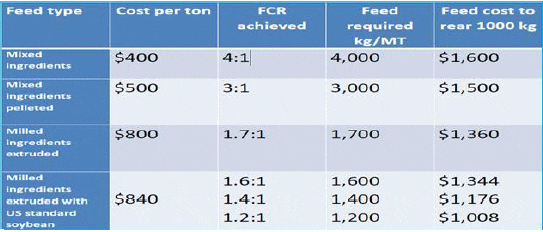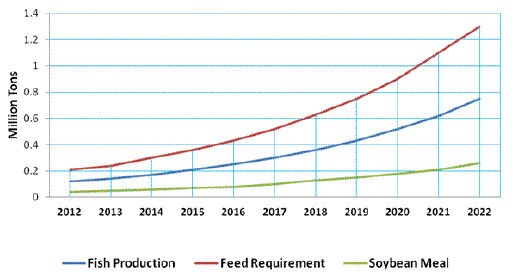On January 29, ASA held a seminar at the Pearl Continental Hotel in Lahore where it disclosed
the results of the feeding trials to more than 120 participants. The results are encouraging, supporting
the initial assumption of increased productivity through good feed use and management.
In November 2011, with the funding support of USDA, a memorandum of understanding (MOU) was signed between American Soybean Association (ASA) and Fisheries Development Board (FDB) to implement a multi – pronged three-year program “Feeding Pakistan – a Research Initiative Focusing on the Aquaculture Industry”. The purpose of the program was aimed at improving the capacity, productivity, and product quality of the Pakistani aquaculture sector. Due to limited research, public information, and availability of high quality fish feed, the project was implemented under two objectives:
- Enhance the capacity of targeted public and private stakeholders through research and dissemination of results.
- Increase the production output of fish farmers by adopting research findings on best aquaculture practices.
Feeding Trials:
To meet the objectives, the project made an assessment of the aquaculture sector in Pakistan. The findings highlighted a sector in dire need of good inputs and management practices. Consequently, trials were implemented at seven sites throughout the country (See map), of which three were conducted in cages and the remaining four in ponds. Due to the lack of quality inputs in the country, the fry was purchased in Thailand, while two consignments of 44,000 lbs each of floating fish feed made with U.S. soybean meal were shipped from Idaho, USA. The data collected on the fish feeding trials were based on the following parameters:
- Feeding trials on Tilapia for monitoring growth using pelletized floating fish feed based on U.S. soybean meal (SBM)
- Feeding trails will test the efficacy of fish feed in local conditions of Punjab and Sindh; the main aquaculture areas in Pakistan.
- Measuring feed conversion ratios (FCRs)
Capacity Building:
To capitalize on the feeding trials, capacity building activities were outlined, these included:
- Strengthen the capacity of local feed-mills ( with extruder) to prepare standard fish feed with imported SBM
- Demonstration sites to showcase intensive aquaculture in Pakistan.
- Build private and public capacity through technical backstopping and information provision.
A Cochran team travelled to the United States to learn about the U.S. aquaculture industry which resulted in the purchase of an extruder and a floating pellet machine by a local Pakistani company, Oryza Organics. In addition, six Field Research Officers (FROs) were employed and trained in intensive tilapia production and were given the responsibility to supervise the trials, provide technical assistance at the sites, and collect research data. At the sites, farmer field days were organized in which over 500 farmers participated to learn first-hand modern aquaculture technologies and best management practices. This year another delegation is ready to receive training and to attend the 2013 Aquaculture World Conference & Exhibition held in Nashville, USA. An estimated 1,500 stakeholders will receive some sort of training through seminars and farmer field days because of this program.

Results and Seminar
The seminar attracted considerable interest as more than 120 people attended, surpassing the expected attendance. Participants included farmers, millers, researchers, government officials and academia. The Chief Executive Officer (CEO) of FDB, Mr. Faisal Ifthikar, gave the welcoming remarks in which he alluded that the tilapia industry in Pakistan has a $1 billion potential. Dr. Kevin Fitzsimmons, leading tilapia expert from the University of Arizona, stated that he believes that the aquaculture industry has a potential annual growth rate of 20 percent or more for the foreseeable future.
Among the key findings in the trials were:
- Feed conversion ratio (FCR) ranged from 1.18 to 2.55 with an average of 1.74.
- Yield varied from 1.2 tons/acre to 7.3 tons/acre.
- Average fish weight ranged from 212 to 770 grams/fish.
- No significant differences in productivity were found between ponds and cages.
- The variability in results was attributed to environmental factors, poor aeration, management experience, and lack of experience handling fry.
Dr. Fitzsimmons presented the following table indicating the return on the type of feed utilized, this was a key point as attendees were able to gauge the importance of good aquaculture practices, as it was clearly demonstrated that fish farms that applied good management practices could attain good FCRs.

Forecast
The following scenario forecasts aquaculture production, feed demand, and soybean meal demand for the next 10 years. Production is expected to increase from 120,000 tons in 2012 to 750,000 tons in 2022 a 525 percent increase, based on an average FCR of 1.7. The demand for fish feed will increase from 210,000 tons to 1.3 million tons, and soybean meal demand from 42,000 tons to 260,000 tons.
Projections: Fish Production, Feed Requirement, and Soybean Meal

Conclusion
The FEEDing Pakistan Aquaculture project has been able to demonstrate that Pakistan has the potential to develop a modern aquaculture industry through good feed use and aquaculture practices. Many challenges remain, as the existing supply chain is weak. However, at the seminar, many stakeholders indicated that they are or have already ventured in key areas such as feed processing, nursery management, and cage production. Although the tilapia produced in the trials received a premium in the marketplace, the marketing chain needs improvement. No cold chain storage and processing facilities exist, and post-harvest handling techniques are deficient resulting in seasonal demand for fish during winter months. Developing the marketing chain is critical for Pakistani aquaculture producers to tap into the domestic market year-round and export abroad.
Finally, and of utmost importance for U.S. agriculture, progressive fish-farmers have great interest in using high-quality soy-based feed. They are starting to explore the possibility of importing U.S. soybean meal. FAS Islamabad will work closely with ASA to capitalize on this development, especially, according to ASA, as Pakistan would need to source from either the US or South America as India’s domestic production is not expected to keep up with rising demand by 2018. In 2011, Pakistan imported over $150 million of soybean meal from India.
March 2013




